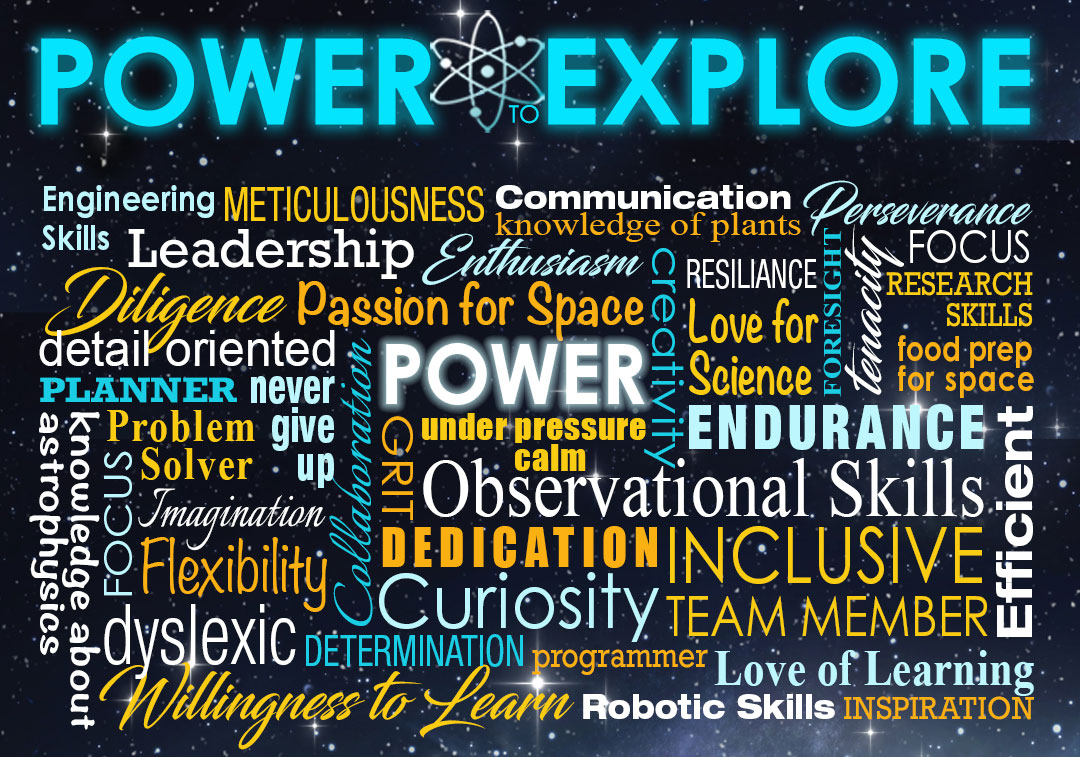News | March 8, 2023
NASA Names Semi-Finalists of the Power to Explore Challenge

A word cloud of “super powers” of the 45 semi-finalists. Credit: NASA/Glenn Research Center
NASA selected 45 student essays as semi-finalists of the Power to Explore Challenge, a national competition for K-12 students featuring the enabling power of radioisotopes.
Contestants were challenged to explore how NASA has powered some of its most famous science missions and to dream up how their personal “super power” would energize their success on their own radioisotope powered science mission. The competition asked students to learn about Radioisotope Power Systems (RPS), a type of “nuclear battery” that NASA uses to explore some of the most extreme destinations in our solar system and beyond.
Inspired by the Planetary Science Decadal Survey, a report from the science community that prioritizes science mission concepts for NASA to consider, students wrote about a mission of their own that uses this space power system and wrote about their own power to achieve their mission goals in only 200 words or less.
This year’s contest received nearly 1,600 submitted entries from 48 states, Puerto Rico, Guam, and the U.S. Armed Forces.
Building upon a 60-year legacy, NASA’s RPS program works in partnership with the Department of Energy to deliver power systems and technology for science missions to some of the dustiest, darkest, most distant, and harshest environments in the solar system. RPS enable NASA to explore the surface of Mars with the Curiosity and Perseverance rovers, Pluto and beyond with the New Horizons spacecraft, and interstellar space with Voyager 1 and 2.
The Power to Explore Challenge offered students the opportunity to learn more about these reliable power systems, celebrate their own strengths, and interact with NASA’s diverse workforce. This year’s contest received nearly 1,600 submitted entries from 48 states, Puerto Rico, Guam, and the U.S. Armed Forces.
“At NASA there is space for everyone and The Power to Explore Challenge is the perfect way to help inspire students to dream and dare mighty things,” said Sandra Connelly, NASA’s deputy associate administrator for the Science Mission Directorate in Washington. “As our future generation, their ideas are important for the advancement of science, exploration, technology development, and discovery that make it possible for NASA missions to achieve success now and in the future.”
Entries were split into three categories: grades K-4, 5-8, and 9-12. Every student who submitted an entry received a digital certificate and over 6,800 participants who signed up received an invitation to the Power Up virtual event. Students learned about what powers the NASA workforce to dream big and work together to explore with NASA’s Carl Sandifer and Lauren Clayman, as well as scientist Shannon MacKenzie of Johns Hopkins University Applied Physics Laboratory.
Fifteen national semi-finalists in each grade category (45 semi-finalists total) have been selected. These participants also will receive a NASA RPS prize pack.
Grades K-4
- Nadia Teusan, Hudson, OH
- Zachary Tolchin, Guilford, CT
- Achyut Balaji, Portland, OR
- Shanaya Pandey, Peninsula, OH
- Liam Gustavson, Farmington, UT
- Nikhil Gaddam, Los Angeles, CA
- Sofia Chiaravalle, Brick, NJ
- Noelle Moore, Hamilton, NJ
- Katherine Wang, Paramus, NJ
- Luca Dantas, West Greenwich, RI
- James Bigley, Strongsville, OH
- Carmelo Salguero, Athens, GA
- Luca Pollack, Carlsbad, CA
- Simon Gurin, Asheville, NC
- Nikhil Bhavsar, San Jose, CA
Grades 5-8
- Mohamed Elshabeiny, North Bergen, NJ
- Hana Milosavljevic, Austin, TX
- Maxwell Yurko, Reisterstown, MD
- Anna Hullet, Yakima, WA
- Amaar Aslam, Oklahoma City, OK
- Robert Perry, Medford, MA
- Christian Li, Lewis Center, OH
- Aadya Karthik, Seattle, WA
- Kinsley Muntean, Dammeron Valley, UT
- Ella Park, Gaithersburg, MD
- Adoneyas Shegaw, Alexandria, VA
- Rainelle Yasa, Los Angeles, CA
- Aditya Kumar, Plainfield, IL
- Madeline Male, Fairway, KS
- Adyant Bhavsar, San Jose, CA
Grades 9-12
- John Turner-Smith, Miami, FL
- Phoebe Zivkovich, Wantagh, NY
- Coleman Turner, Summerville, SC
- Bethany Davis, Bonita Springs, FL
- Aarin Bothra, Aurora, IL
- Ryan Stanford, Mahwah, NJ
- Alyssa Katsuyama Wang, San Marino, CA
- Jayden Hur, La Canada Flintridge , CA
- Audrielle Paige Esma, Wildwood, FL
- Jane Baisley, Wilmette, IL
- Prachi Thakkar, Ashburn, VA
- Hasan Maharoof, Catonsville, MD
- Marc Epp, Rancho Palos Verdes, CA
- Catherine Purirojejananon, Levittown, NY
- Kevin Tierney, Wantagh, NY
About the Challenge
The challenge is funded by the NASA Science Mission Directorate’s RPS Program Office and administered by Future Engineers under the NASA Open Innovation Services 2 contract. This contract is managed by the NASA Tournament Lab, a part of the Prizes, Challenges, and Crowdsourcing Program in NASA’s Space Technology Mission Directorate.


